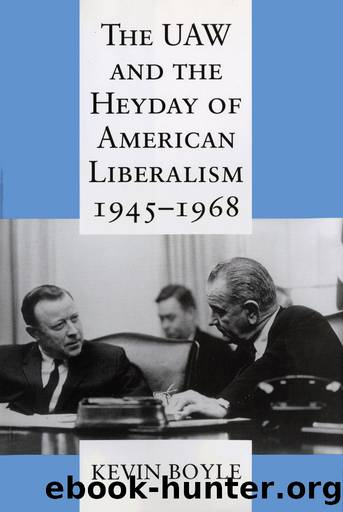The UAW and the Heyday of American Liberalism, 1945 1968 by Kevin G. Boyle

Author:Kevin G. Boyle [Boyle, Kevin G.]
Language: eng
Format: epub
Tags: Labor, Labor & Industrial Relations, United States, Industries, Automobile Industry, 20th Century, Political Science, History, General, Business & Economics
ISBN: 9780801485381
Google: mt4ZDgAAQBAJ
Goodreads: 709532
Publisher: Cornell University Press
Published: 1995-11-21T00:00:00+00:00
8. UAW participants in the March on Washington, August 28, 1963. (Archives of Labor and Urban Affairs, Wayne State University)
The UAW had never been particularly close to the SNCC leadership. The union had provided moral support and a small degree of financing for SNCCâs grass-roots efforts and SNCC had entertained hopes of more extensive ties with the union, but they had never developed. Indeed, in late July, Reuther and SNCC had clashed over the pending civil rights bill. SNCC spokesmen had insisted that the LCCR support an amendment to the bill requiring the immediate transfer of all pending voting rights cases from state courts to the nearest federal court. Joseph Rauh knew that the Justice Department would be horrified by the idea and that the resulting controversy would damage the billâs chances of enactment. He recalls: âI said to Walter, âGod, we canât do that. Youâd better be here. These crazies might put it over. . . .â The people who proposed it were little fish, and Walter spoke and the thing was over.â Now Reuther took the group on once again. At the request of the Justice Departmentâs Burke Marshall, Reuther immediately contacted the archbishop, who agreed not to issue his statement until the morning. Reuther then tried to persuade the SNCC leadership to change Lewisâs text. They refused. â[W]hen I talked to them . . . they pounded on my chest with great emotion and deep feeling,â Reuther recalled a few weeks later. âThey said: âDo you realize that five of our leaders are in prison in the South charged with sedition? They could be executed.ââ By morning Lewisâs speech was still intact.43
The UAW president had hoped to make another attempt during the next dayâs luncheon session but the march had begun early and the speakers had to go straight to the Lincoln Memorial. When Reuther arrived, a call came for him from the White House: the archbishop, he was told, would wait no longer. Reuther quickly called the march leaders together and, with no time left for negotiation, simply browbeat Lewis. âSix weeks ago we formed a coalition,â he said. âNow John Lewis has written a speech. . . . We have no right to tell him what he has a right to say in America, but we have a right to say that if you want to use the platform which this coalition made possible, you are morally obligated to speak within the policy framework around which the coalition came into being. . . . If John Lewis feels strongly that he wants to make this speech, he can go someplace else and make it, but he has no right to make it here because if he tries it he destroys the integrity of our coalition.â Lewis said nothing as Randolph polled the speakers, who voted unanimously to deny SNCC the platform unless Lewis changed his remarks. King, Randolph, and Eugene Carson Blake of the NCC then took Lewis aside to help him redraft the text while Reuther phoned the archbishop, who arrived fifteen minutes later under Secret Service escort.
Download
This site does not store any files on its server. We only index and link to content provided by other sites. Please contact the content providers to delete copyright contents if any and email us, we'll remove relevant links or contents immediately.
International Integration of the Brazilian Economy by Elias C. Grivoyannis(86712)
The Radium Girls by Kate Moore(11877)
Turbulence by E. J. Noyes(7902)
Nudge - Improving Decisions about Health, Wealth, and Happiness by Thaler Sunstein(7471)
The Black Swan by Nassim Nicholas Taleb(6954)
Rich Dad Poor Dad by Robert T. Kiyosaki(6326)
Pioneering Portfolio Management by David F. Swensen(6175)
Man-made Catastrophes and Risk Information Concealment by Dmitry Chernov & Didier Sornette(5883)
Zero to One by Peter Thiel(5643)
Secrecy World by Jake Bernstein(4601)
Millionaire: The Philanderer, Gambler, and Duelist Who Invented Modern Finance by Janet Gleeson(4309)
Skin in the Game by Nassim Nicholas Taleb(4128)
The Age of Surveillance Capitalism by Shoshana Zuboff(4126)
The Money Culture by Michael Lewis(4033)
Bullshit Jobs by David Graeber(4003)
Skin in the Game: Hidden Asymmetries in Daily Life by Nassim Nicholas Taleb(3873)
The Dhandho Investor by Mohnish Pabrai(3642)
The Wisdom of Finance by Mihir Desai(3615)
Blockchain Basics by Daniel Drescher(3435)
